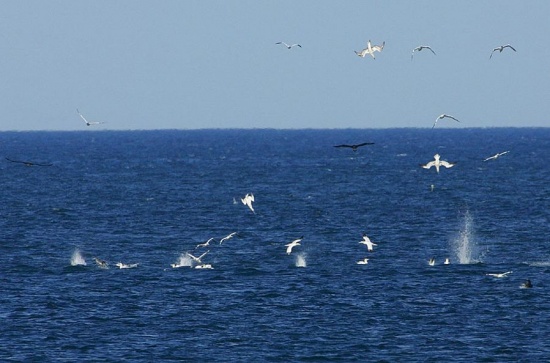| This article is incomplete. This article is missing one or more sections. You can help the BirdForum Opus by expanding it. |
Overview
Fife Ness lies on Scotland's North Sea coast at the tip of the Fife Peninsula. Any promontory on the British east coast is likely to produce good numbers and variety of migrants and Fife Ness is no exception.
The shore is rocky with small patches of sandy beach backed by coastal scrub, farmland and a golf-course. Although passerine migrants are the main attraction of Fife Ness there seabirds to be seen offshore and a few passage waders occur. Any patch of scrub on this peninsula is worth checking for migrants but take great care to avoid trespassing onto private property.
Birds
Notable Species
All the regular passerine migrants such as pipits and wagtails, chats, warblers, thrushes and finches occur as well as scarcer species. Seen with some frequency in spring are Bluethroat, Black Redstart and Ring Ouzel and Red-backed Shrike and Common Firecrest are occasional visitors. Scarcer still are Common Rosefinch and Ortolan Bunting. Pallas's Leaf Warbler is an occasional autumn visitor.
Non-passerine migrants include Long-eared Owl and Wryneck, both regularly recorded in spring. Autumn passage brings larger numbers and birds such as Yellow-browed Warbler and Pallas's Warbler are regular with occasional Red-breasted Flycatcher.
Offshore Northern Gannet, Great Cormorant and Shag can be seen all year with scarcer species on passage and in winter. Red-throated Diver, Black-throated Diver and Great Northern Diver are all possible, Manx Shearwater and Sooty Shearwater regularly seen in autumn as well as Arctic Skua, Great Skua and sometimes Pomarine Skua with the occasional Long-tailed Skua.
North to north-easterly winds produce the best seawatching and this is one of the most regular Scottish sites for Sabine's Gull.
The commoner terns pass the point on migration and Black Tern and Little Gull are regular. Little Auk can sometimes be seen in late autumn after severe storms. The rocks of the beaches hold wintering Turnstone and Purple Sandpiper.
Check-list
Birds you can see here include:
Red-throated Diver, Black-throated Diver, Great Northern Diver, Northern Fulmar, Sooty Shearwater, Manx Shearwater, Great Cormorant, European Shag, Common Eider, Eurasian Oystercatcher, Common Ringed Plover, Purple Sandpiper, Dunlin, Ruddy Turnstone, Pomarine Skua, Arctic Skua, Long-tailed Skua, Great Skua, Little Gull, Black-headed Gull, Common Gull, Lesser Black-backed Gull, European Herring Gull, Great Black-backed Gull, Black-legged Kittiwake, Sandwich Tern, Common Tern, Arctic Tern, Little Tern, Black Tern, Common Guillemot, Razorbill, Little Auk, Long-eared Owl, Eurasian Wryneck, Eurasian Skylark, Meadow Pipit, Bluethroat, Black Redstart, Whinchat, European Stonechat, Northern Wheatear, Ring Ouzel, Eurasian Blackbird, Fieldfare, Song Thrush, Redwing, Mistle Thrush, Sedge Warbler, Common Chiffchaff, Yellow-browed Warbler, Pallas's Leaf Warbler, Willow Warbler, Goldcrest, Common Firecrest, Spotted Flycatcher, Red-breasted Flycatcher, European Pied Flycatcher, Blue Tit, Great Tit, Red-backed Shrike, Eurasian Magpie, Carrion Crow, Common Starling, House Sparrow, Chaffinch, European Greenfinch, European Goldfinch, Eurasian Linnet, Yellowhammer, Corn Bunting
Other Wildlife
To do
Site Information
History and Use
To do
Areas of Interest
To do
Nearby Sites of Interest
Kilconquhar Loch
Kilconquhar Loch is a freshwater loch, with an ongoing birding presence, near a town by that same name in the Fife area.
The pronunciation of Kilconquhar is not what one might think, based upon the spelling of it, but correctly pronounced is, instead, Kin-nuchar. [5]
Access and Facilities
The Scottish Wildlife Trust manages a small area at Fife Ness Muir towards the tip of the point and also a stretch of coast to the south at Kilminning.
To explore Fife Ness Muir take the A917 to Crail then the minor road eastwards to Balcomie. Park at the golf-course and walk through the gate to the right of the road, then immediately left towards the sea.
For Kilminning turn right off the Balcomie road about 1.5km out of Crail and park at the far end of the track.
Contact Details
To do
External Links
Content and images originally posted by Steve




